By: Thorsten Overgaard. August 23, 2015.
Add to Flipboard Magazine.
Hello Paris
It is always interesting when you walk around a city casually, how you see stories and compositions. You walk by an open door, and in the moment you turn your head, you see a picture.
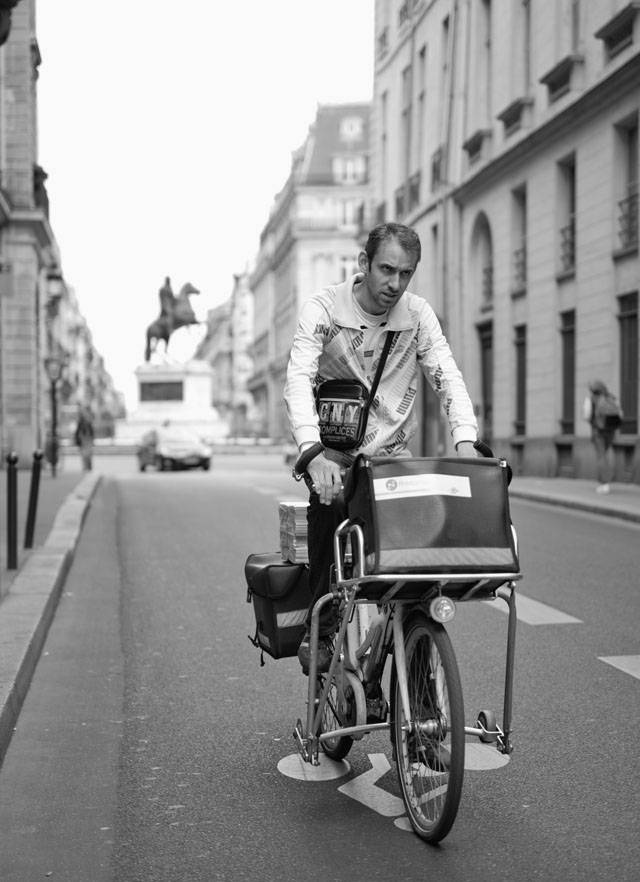
It's hard to tell if this expression is because he is being photographed by me or because he has to endure another day in the city of Paris. Leica M 246 Monochrom with Leica 50mm APO-Summicron-M ASPH f/2.0
People think they need to go to exotic places to find good pictures, but walking anywhere for any or no reason you bring about surprising things. The good pictures happens unexpected.
That’s why any excuse to walk to the bakery to buy bread, or decide to go for a walk and an ice cream is a possibility to open your eyes for a picture.
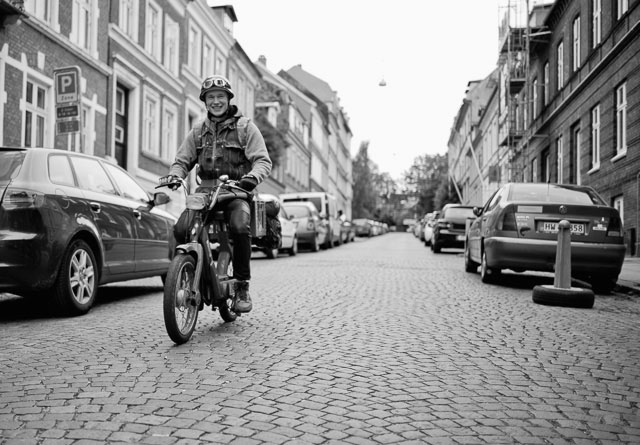
In my hometown Aarhus we went to get an ice cream and walked up the street. Two guys were leaving for one of the summer music festivals in Denmark and was dressed in 1970's clothing and with their 1970's Puch Maxi scooters. A very unlikely and unexpected event, but it happened and I got a few photos of it. When I think of it, something always happens when you get out and about with a camera. Leica M 246 with Leica 28mm Summilux-M ASPH f/1.4.
When I say walk, that’s one possibility. Driving is also a way to do it, but you have to get out of the car and often the perspective looks different when out of the car. I tried so many times stopping the car and get out, just to realize that I couldn't get the same frame as I saw from the car (so often I have more success with taking the photo from inside the car when I see it).
Some people have drivers and may feel they are locked inside a car in heavy traffic every day. I know, some will find this an odd problem, but there are actually parts of the world where having a driver is the way to deal with transportation (in Bangkok a drivers salary is $200 a month). Interesting problem. But you have the freedom to stop the car and walk out if you sense there is something to see. If the traffic isn't moving, then why sit and wait in the car if you can step out and enjoy the freedom for a moment? Take a walk with the camera.
We all have difficult life's that prevent us from taking pictures and makes it so much easier for everybody else. Right? The person forced to take the New York Subway every day and nothing ever happens, or the person who sail on the same boring ferry across the Bosphorus Strait in Istanbul every morning and evening to work. Nothing to see, nothing to take photographs of.
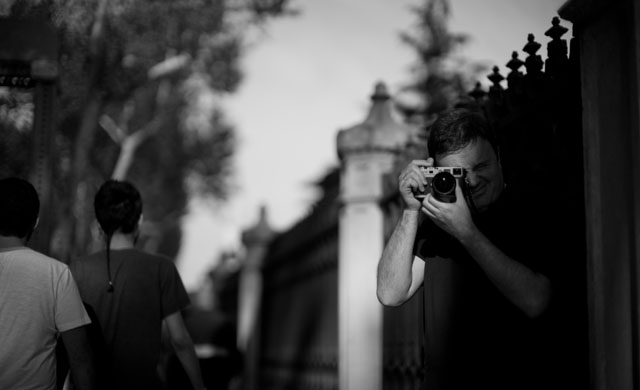
Another uneventful day in Istanbul. Not really, but it helps to be a stranger who isn't used to the exotic architecture and the exiting light. Here it is Pavel Bukhtiychuk from Moscow, Russia in my Istanbul workshop.
It just isn't true that nothing ever happens. But it is true that if you look but don't actually see, it will be a repetition. If you feel you are experiencing the same every day, then bring a camera and try to imagine what someone from another part of the world would notice. That should stop the complaining that it's always the war photographer who goes to Africa who gets the good pictures.
It's true that traveling opens your eyes. Not because the surroundings necessarily becomes more interesting, but because you become more interested in seeing.
Walking in Paris I can feel I've seen it all after a few days, but I keep walking. Suddenly you turn a corner and the light changes or you see an interesting person approaching you on the street. I have tried it so many times; you are getting tired and it just isn't your day today. But then two seconds later you see something that inspires you, and there you go!
Some times you just imagine a picture. You see the framework to a picture or sense that a story is unfolding down the street. It requires some more elements to be there. You somehow already have envisioned the composition and what should be in place for it to work. So you hang back and wait for the element that will complete the vision.
When I walked through Paris I visited some familiar places, and one led to the next one, but then suddenly, just a few hundred meters from an area I know well, I was in a completely new area I hadn't seen before. Or maybe I had seen it before, I just hadn't noticed.
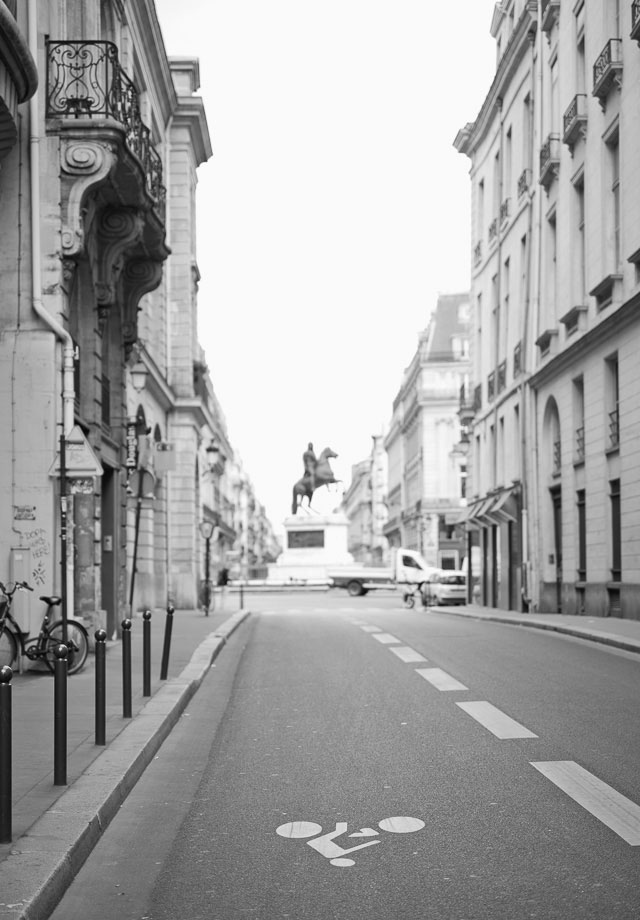
Some times I will take a picture of a space like this because I know there is something about it. It becomes obvious very quickly that something is missing, but also that something is there. I will do one more to establish how the light and depth of field will look if I have an imagined subject in the front somewhere. It's the same I do when I prepare a location for a portrait. Will the frame work with the imagined subject in front? Leica M 246 Monochrom with Leica 50mm APO-Summicron-M ASPH f/2.0
It was late afternoon and the light had begun to look interesting. Soft light with a low sun creating some sparkling edges on the buildings and in the faces of people.
I found myself in a small crossing of four streets and I decided for a frame with a statue at the end of the road and with good backlight. I spent what felt like half an hour there, but i actual fact it was only 8 minutes. I was waiting for something interesting to come into my frame. I liked the frame, but I needed a person of some sort in it.
When I say wait, I mean being ready to photograph when something like a bicycle, an interesting car or a scooter comes approaching. I set my focus for one spot, hold onto the frame I have decided and wait for the subject to arrive in the area where I set the focus. Then I take 2-3 photos and hope one of them captured the subject with an interesting expression or gesture in focus.

Advertisement:
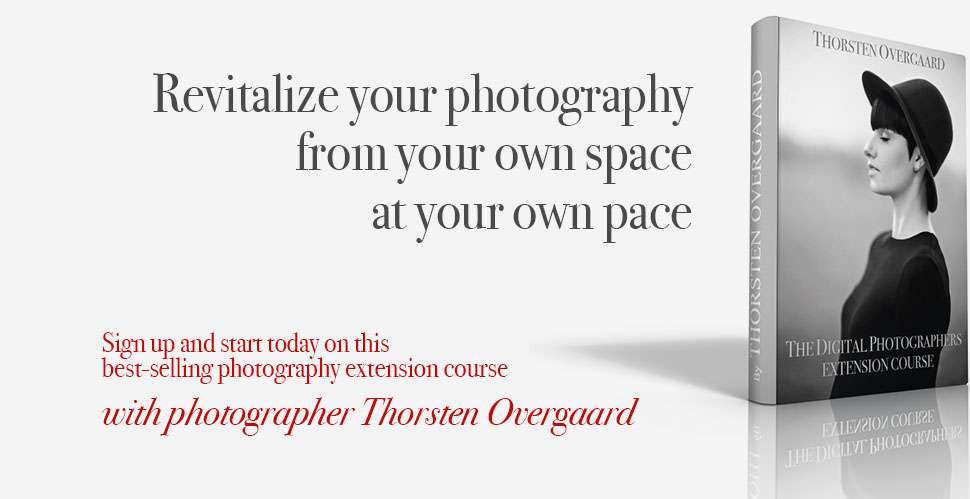

My photo required that I was standing on the street which may or may not be a wise decision in parisian rush-hour traffic. Motorized traffic in Paris already seem like a modern way of horseback jousting fight with lances, and even on a relatively quiet street another person obstructing the road seemingly was very provocative to some!
As I recall the day, I waited a long time for my subject. But in retrospect, looking at the time stamps on the files in Lightroom, it only took two minutes before a man arrived and waved to the other photographers who had placed them self on a more secure location on the sidewalk.
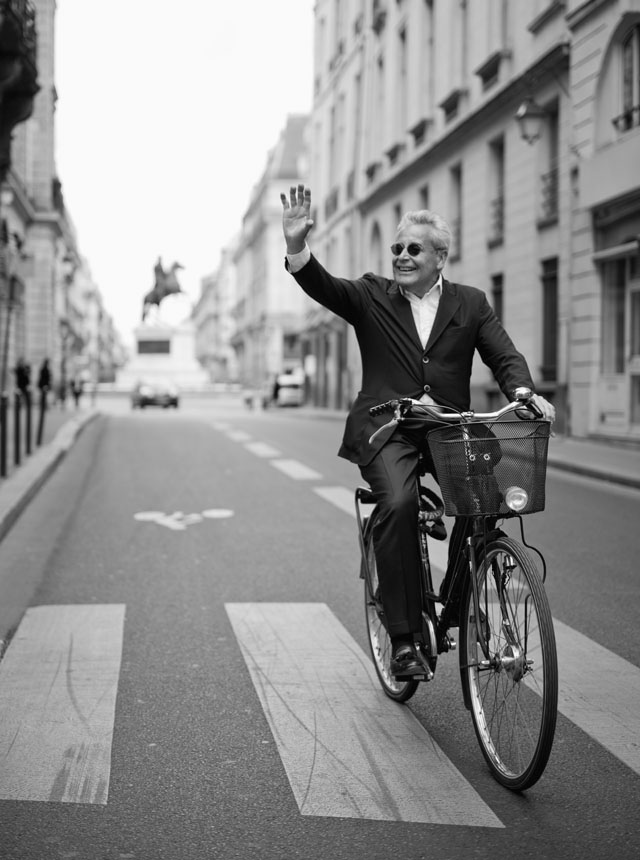
Hello Paris! Leica M 246 Monochrom with Leica 50mm APO-Summicron-M ASPH f/2.0
That's the sort of unexpected bonus you can't calculate. And that is one reason to be ready for the subject. You never know if it will be an elegant lady with a grand Dior hat or a Hells Angels motorbike who is the next subject in your frame.
Before he arrived, a scooter with two guys had actually tried to torpedo me, so I was already in the process of calculating the risk versus award for waiting around longer.
It's interesting to analyze my image strip now, four months later. I realize my concept of time and what I remembered is different than what actually happened.
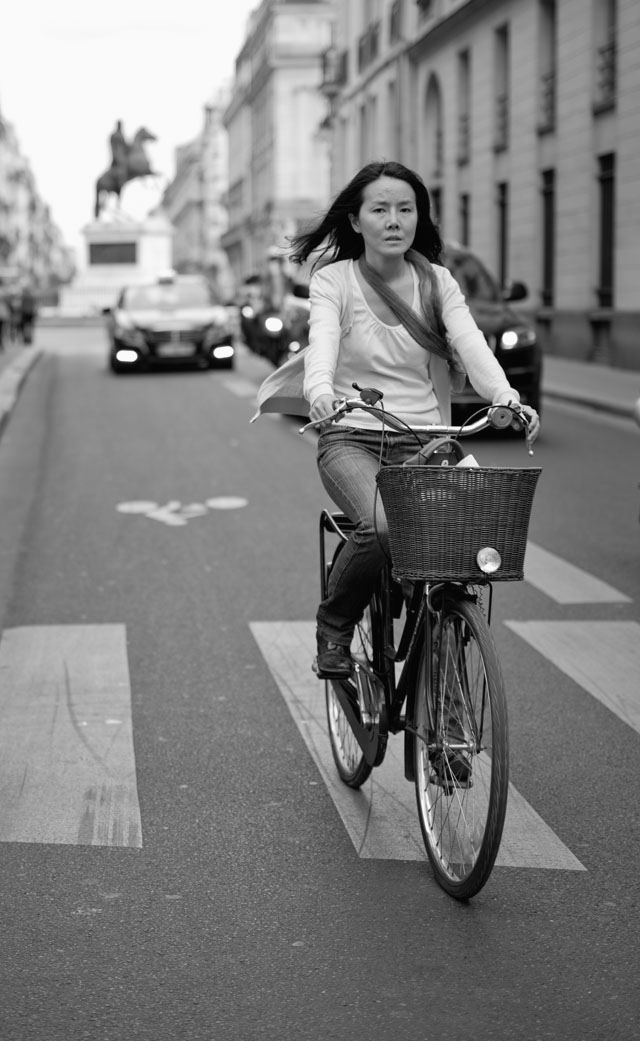
Another possible subject. You don't know till after how the balance will be, the expression of the subject or if something interesting is happening in the background. Leica M 246 Monochrom with Leica 50mm APO-Summicron-M ASPH f/2.0.
Some times I revisit a location again and again if I was lucky with it, or if I had only partly luck but feel I didn't utilize the full potential of the scene. Some time I am right to do so, at other times it just doesn't get better.
Just around the corner from this location we found a church and an interesting square we spend another half hour exploring, but that's another story for another day.
Let me finish with a quote from Henri Cartier-Bresson who spent a life in Paris:
"The only correction is to make the next picture if you are not satisfied. You try another solution. That’s why a contact sheet is so interesting because you see how a man has been thinking photographically, with his brain, with his eyes, his feet and everything with himself." - HENRI CARTIER-BRESSON
 |
NEW VERSION 11.3 |
 |
| |
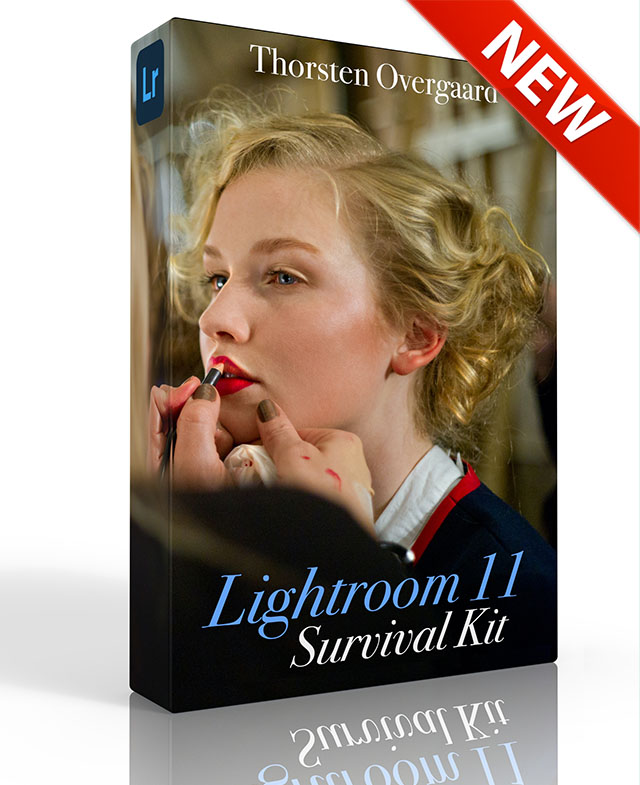 |
|
| |
|
| |
|
|
|
|
| |
|
| |
|
|
| |
Buy Now. Instant delivery.
New Version 11.3
ONLY $698.00

Now includes
4+ hours of
video tutorials.
100% satisfaction
or 100% refund.
More info.
|
|
| |
#2130-1121-3 |
|
| |
|
|
| |
Update to Version 11.3
Apply
code "UPDATE113" on checkout to get this complete version 11.3 update.
$298.00

Updates all previous Surival Kit versions since 2009. |
|
| |
|
|
Buy the complete new
Lightroom Survival Kit 11.3
The Legendary Tutorial for Photographers
Brand-new JUNE 2022-version.
Now with brand-new 4+ hours of video tutorials.
New sections on compostition and storytelling.
How to edit color photos.
How to edit black & white photos.
How to do keywords logical and easy.
The most successful photo editing kit ever
Photographer Thorsten Overgaard first released the Lightroom Survival Kit in 2009 and have honed it with new and fresh updates. This Version 11 is the most radical updated and renewed version ever, four years in the making.
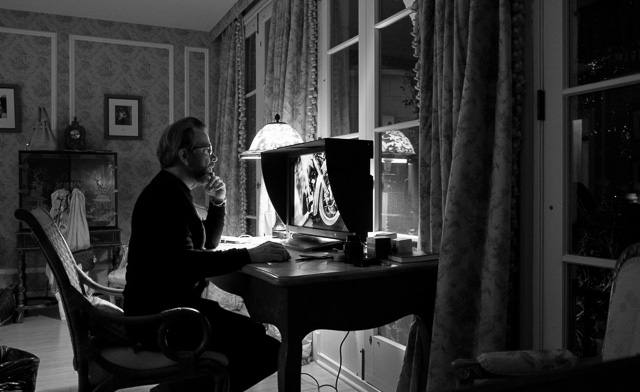
Professional workflow experience made simple, logical and easy to use.
Master editor makes it simple to understand
The Survival Kit is unique and one-of-a-kind being made for photographers for photographers. When someone understands their subject, they can explain it so it is easy to understand. The hallmark of Thorsten Overgaard is to make expert knowledge shown and told in a way so anyone can apply it.
Hands-on advice that works
With a 450 pages workbook and 4+ hours of video, every element of digital photography is touched on, in handy chapters and pre-flight checklists. Editing of color vs black and white photos, keywording, cropping of images, fine-tuning of tones, color balance and color control, export of originals, printing, archiving and backup, and much more.
Comes with the Overgaard Leica Presets (Value $48)
The Lightroom Survival Kit comes with Thorsten Overgaard's special-made Lightroom Presets for all digital cameras and for Leica digital cameras.
Understand all from camera to the final print
Chapters in this version goes over the background for High Dynamic Range (HDR), digital raw files and how to set up a professional photography workflow, from calibrating the screen to editing in Lightroom, and to making a final print. And more ...
10+ years experience in one package
No need to spend years figuring out the smartest way to do things when you can tap into the best way of doing things right here. The workflow of Thorsten Overgaard as been refined through years of field work with more than a thousand workshop attendees.
This method of workflow now used by thousands
The Survival Kit has been taught to thousands in workshops and in this Survival Kit. What does it do? It make you enjoy taking and making photos, and it increases your production considerabely. Most important of all, it'll give you back ownership of your files (which you will understand why is so important, once you have bought the Survival Kit and started applying its methods).
| |
|
|
| |
"Thorsten's methodology is perhaps not what hardware-, software- and cloud-companies want us to do, but as a former IT engineer I can only acknowledge his views about preserving our digital heritage. This workflow explained is for me the best I have ever seen".
★★★★★ |
|
| |
|
|
Video tutorials, image files, presets, checklists, definitions, tutorials of Lightroom, that boils down years of experience to a workflow you can implement in less than one day.
Start working in minutes. |
|
|
| |
|
| |
|
| |
|
| |
|
| |
|
| |
|
|
|
|
 |
|
 |
I hope you enjoyed today's Story Behind That Picture. As always, feel free to mail me at thorsten@overgaard.dk with comments, suggestions and questions.
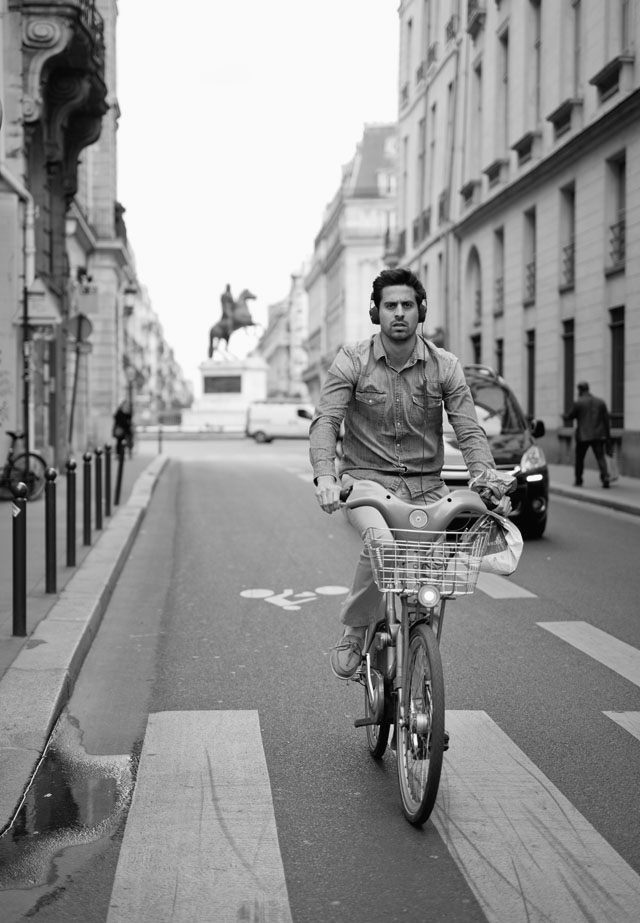
Another one. As you can tell I am just waiting for the right one. You can't know if the background is going to be filled with a ugly car or a classic Ford T. Leica M 246 Monochrom with Leica 50mm APO-Summicron-M ASPH f/2.0.
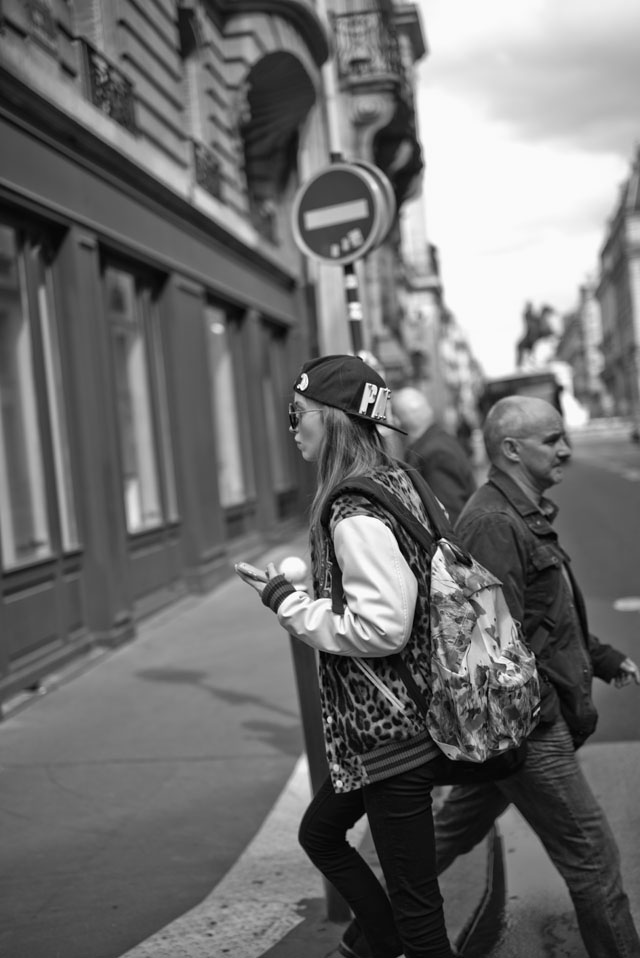
One more before we leave. Leica M 246 Monochrom with Leica 50mm APO-Summicron-M ASPH f/2.0.
| Thorsten Overgaard, August 23, 2015 |
![]()
